Domestic multiply charged hand grenade launchers
Hand grenade launcher TKB-0249 "Crossbow"
I would like to start with a rather interesting sample of a manual multiply charged grenade launcher, which was developed at the end of the 90-s of the last century under the leadership of Valery Nikolaevich Telesh. Initially, the goal was to create a hand-held grenade launcher that satisfies the needs of both military and law enforcement agencies, that is, in essence, this grenade launcher was to become to some extent universal. This weapon was first shown to the public in 1998. They became interested in the grenade launcher, and not only domestic visitors of the exhibition, but also foreign ones showed interest.
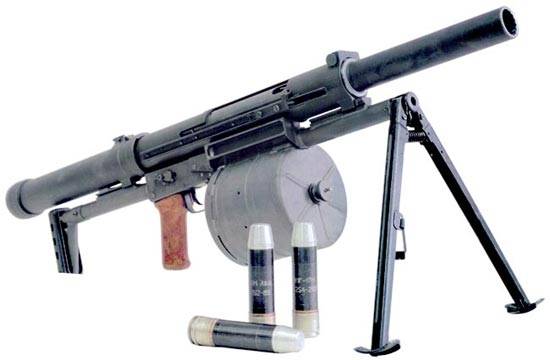
Apart from the fact that the Arbalet grenade launcher has a fairly simple and thoughtful design that does not require significant costs in production and allows you to deploy production virtually “on the knee”, this weapon turned out to be quite attractive even by modern standards, though not quite usual in its layout . No less attractive are the characteristics of the weapon, thanks to which, with the light hand of journalists, the manual grenade launcher “Crossbow” was dubbed sniper. Indeed, the characteristics of the weapon make it possible to hit targets at a distance of up to 150 meters with a sufficiently high accuracy, and this is due not only to the ammunition, but also to the design of the weapon itself, although the indicators are not that sniper, but this is slightly lower.
Conventionally, the TKB-0249 grenade launcher can be divided into two parts, upper and lower. In the upper part of the receiver is located with a fairly heavy shutter and barrel weapons. The lower part consists of a trigger, butt, receiver shop and bipod.
An unusual type of weapon is due precisely to the layout, in which the butt is placed below the receiver to reduce the overall length of the weapon. This arrangement has a positive effect on the convenience of holding a grenade launcher when firing without using bipods, since the weight of the weapon can be distributed between the holding arm and shoulder, and the weight of the grenade launcher “Arbalet” is not a child's 10 kilogram, excluding the store and ammunition.
Such a mass is to some extent even necessary to compensate for recoil when firing, since VOG-17M, VOG-30 and GPA-30 are used in the grenade launcher. That is, it is not a “slow” forty-millimeter grenade launcher shot, but much more nimble, with an initial speed of up to 185 meters per second. But not only the mass is compensated return when shooting. A significant role in the recoil compensation is played by the bolt group, behind which is placed a damper, a tensile recoil moment. It is the minimization of the impact of recoil when shooting make the weapon more accurate in comparison with counterparts.
You can not get past the main drawback of such a layout. Since the axis of the “Crossbow” hand grenade launcher is located significantly higher than the butt of the weapon, even recovered by the weight of the grenade launcher and the damper behind the bolt, recoil leads the weapon away when fired up. This means that after each shot, the grenade launcher will have to be returned to the line of sight, because of the high rate of fire "from the hands" is not achieved, which partially compensate for the bipod on the weapon.
In addition to the open aiming devices, an optical sight and a laser rangefinder can be mounted on the Arbalet manual grenade launcher, which allows for relatively accurate fire on the enemy at distances of more than a kilometer, but it should be understood that an accurate hit at these distances from a single shot is more luck than regularity For firing at such distances, there are a lot of other models of weapons, while the actual distances for using hand-held grenade launchers rarely exceed 400-600 meters, and at this distance the Crossbow shows excellent results. With a great desire and using the GPA-30 shot, you can throw a grenade at a distance of more than two kilometers, but does this make sense?
Separately, you need to say a few words about the power weapons. It feeds on a TKB-0249 hand-held grenade launcher from single-row box magazines with a capacity of 5 shots. In addition, they have developed disc shops with a capacity of 10 shots. There is a mention of box stores with a capacity of 10 shots, but it's hard to believe in it, since stores of such length will make it difficult to use a hand-held grenade launcher with bipods.
The total length of the weapon is 900 millimeters, while the mass of weapons with a magazine equipped with a capacity of 10 shots is more than 14 kilograms. A comparison with a hand-held grenade launcher of the revolving type RG-6 suggests itself, for both in mass and dimensions, the Crossbow loses to the latter, the only advantage in store capacity and reload speed in the presence of already equipped stores, which also need to be worn and which also have volume and mass of Despite this, comparing two hand-held grenade launchers is not entirely correct, since they use different ammunition, which, in turn, have their advantages in certain conditions. Despite this, it is difficult to deny that the WG-6 is easier and more convenient to carry on you in comparison with the Crossbow. To be objective, the TKB-0249 hand-held grenade launcher can be said to occupy an intermediate position between manual and automatic grenade launchers on the machine.
Baryshev automatic hand grenade launcher
No less interesting, but far less comfortable when transporting on its shoulders is the construction proposed by Anatoly Baryshev. And here is the dilemma of telling about the grenade launcher in its original version or about the variant that will be produced in Belarus at the production facilities of Belspetsvneshtekhnika, since this is in its mass-dimensional characteristics two different grenade launchers. It would be more logical to present an overall picture, from the first to the last strokes.
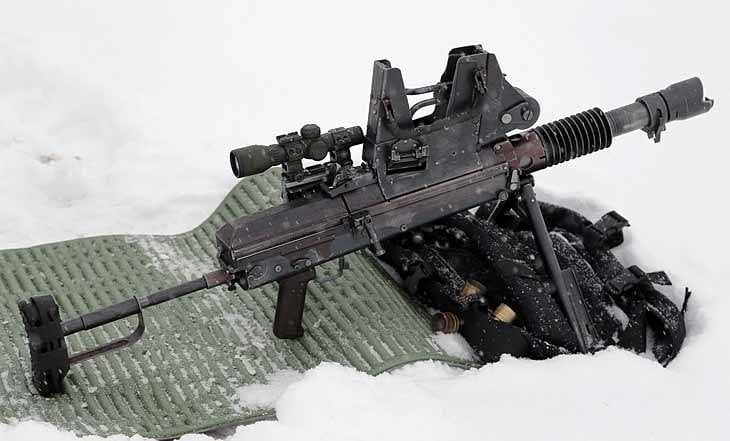
In the past few years, flattering articles on weapons developed by Anatoly Baryshev can be found on the Internet and in print media. It goes without saying that this weapon is compared to what is now in service, and it is not surprising that the current widespread models of weapons lose the same accuracy (if you take the guns). Even I can recall from memory a couple of dozen models of automatic machines that will “beat” at least a little, but more precisely, AK of any year. The main topic of such articles is usually the theme of the bureaucracy and how it interferes with the armament of the army, so to speak, if it hadn’t interfered, then for twenty years all would have been re-equipped with blasters and Tanks jet thrust.
This is partly the way it is, and it's hard to argue with that. Nevertheless, few people consider how much a new automatic weapon or a machine gun will cost in production, how much a complete rearmament will cost and how much the characteristics of this new weapon will change during mass production. So we get that for the sake of a few percent increase in the accuracy of fire, it’s not even millions that need to be spent, but much more. Add to this a comparison of the reliability of work in adverse conditions and in the absence of appropriate care, and everything will fall into place.
I foresee objections in the form of the possibility of small-scale production for the needs of special forces. But, firstly, there are not a couple of hundred special forces in their ranks, so the production will not be small-scale. Go to any forum, there every second served in special forces. Is that the forums of future mothers can not boast of such a feature. Sometimes it seems that the whole army consists of special forces ... Secondly, if you organize a manual assembly and a thorough fit of all the details, then the characteristics of weapons that are currently in service will be much higher than with large-scale production. Even such a simple object as a cartridge may differ in quality, what to say about weapons. But if we talk about the development of individual designers in general.
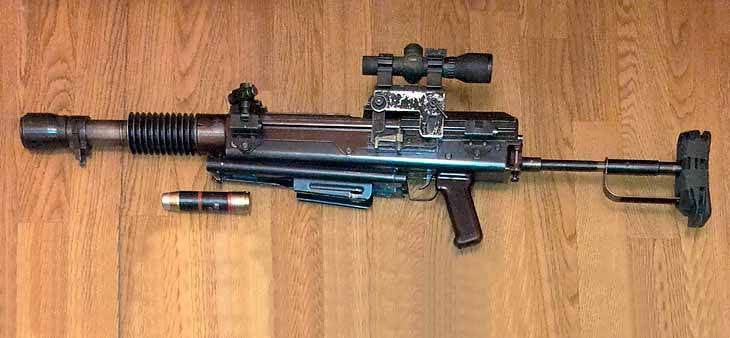
In the case of the works of Anatoly Baryshev, his manual multiply charged grenade launcher must be singled out separately, since this class of weapon is represented by a rather poor list of models. Provided that in certain situations this weapon shows an advantage over automatic grenade launchers of the AGS-17 type and before manual single-shot ones, including grenade launchers, the start of production and adoption is more than justified, since there are few alternatives.
Start counting the time on the time of the first operational samples of the Baryshev manual grenade launcher from the end of the 80-s of the last century. It is clear that at that time, the production of not just a new model of weapons, but a new class of weapons was quite problematic. In addition to the confusion in the country itself, the process was also hampered by the fact that neither the army nor the law enforcement agencies felt an urgent need for a multi-charge grenade launcher. Rather, the need was, but it was from the category of "no, well, okay, there is, well, good," which, in principle, can be observed now, and even in the army of other countries. After the collapse of the Soviet Union, there were attempts to establish the production of weapons in the camps of the terminated Warsaw Pact, in Poland, Bulgaria, Ukraine, but failed, because the designer managed to obtain patents for his weapon, which stopped all movements in this direction.
For almost 30 years, the designer’s weapon was often mentioned in the media, sometimes there was even a hint that the military was finally interested in development and that the full-scale production would begin. Well, finally, we can say that the miracle did happen, Anatoly Baryshev's hand-held grenade launcher will be manufactured at the Belarusian enterprise “Belspetsvneshtehnika”. But with one caveat: the weapon will be slightly different from what was described earlier. This can be explained at least by the fact that the designer himself has made a lot of changes and improvements to his weapon for 30, and the Belarusian specialists are clearly not just getting paid. Let's try to compare what was and what has become the easiest and most accessible way - in numbers.
The most important criterion for such weapons, of course, is its mass. It is indisputable that “gravity is good, gravity is reliable” (c), but not in the case when this gravity needs to be dragged along. In the original version, the Baryshev grenade launcher had a mass of more than 15 kilograms. It seems like quite a lot. For example, AGS-17 weighs 18 a kilogram, though it is useless without a machine and ammunition, on a machine and with a tape on 29 shots its weight is almost 45 a kilogram. That is, we already have an advantage in mass, which means either a reduction in the calculation, or an increased amount of ammunition carried by the calculation. Plus, such important advantages as maneuverability and the possibility of shooting almost from the belt.
Comparison with AGS-17 in this case is relatively correct, since both grenade launchers have the ability to conduct automatic fire with the rate of 350-400 rounds per minute, well, the possible theoretical maximum range for the AGS-17 has little in common with the practical, since shooting at Maximum distances are certainly possible, but it is difficult to get here. But you need to understand that the weapon is not interchangeable. At distances up to 300-400 meters, the ARGB has a clear advantage over AGS-17, as well as an advantage when using weapons in the city, AGS-17 will show higher accuracy for more distant distances. In other words, grenade launchers have separate tasks for everyone, but these tasks partially overlap.
The current version of the hand grenade launcher Anatoly Baryshev has a mass of almost half as much, namely, about 8 kilogram without ammunition. Such a weight loss is really impressive. Honestly, I confess that I did not find information that they managed to lighten the weapon to such an extent, since apart from the general “excuses” in the form of using light alloys and plastic, no one says anything, but you can count how much more grenade launchers can make a difference masses If we take the 7 kilogram of difference and the mass of a shot into the 0,34 kilogram, it turns out that the difference in weight of the old and the new grenade launcher can be dragged off by the 20 shots, provided that the updated weapon can be powered from the tape.
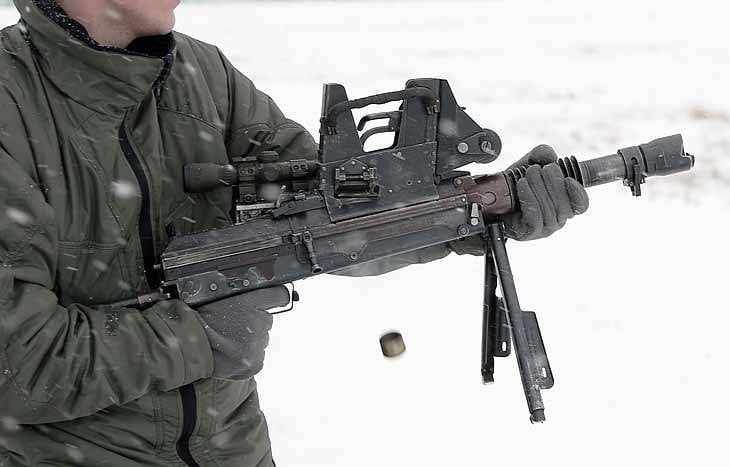
From the reduction in the mass of weapons, it is possible to derive a completely logical question about recoil when firing. It is no secret that a heavier firearm sample, other things being equal, will have a more comfortable return. In this case, you can only rely on the opinion of those lucky enough to try out a lightweight sample. According to their statement, recoil is about the same as when fired from an 12 caliber rifle. What turns back, however, to the idea that the semi-free-shutter automation system, developed by Kiraly once and significantly modernized by Baryshev, copes very well with recoil when using powerful enough ammunition.
As a result, in its current form, Baryshev’s hand-propelled grenade launcher is a weapon with the ability to power both from a ribbon, 29 capacity of grenade launchers, and from a detachable magazine with 6 shots capacity. The mass of weapons without ammunition is 8 kilogram. It is possible to conduct both single and automatic fire. A weapon can be used both when shooting “with hands” and when using folding, height-adjustable bipods. The total length when the butt is unfolded is 900 millimeters, with the butt folded down - 750 millimeters. The length of the barrel is 300 millimeters. It remains only to adapt this weapon for ammunition with a programmable fuse and XM-25 will be far overboard. True, at first such grenade launchers should be launched into mass production.
GM-93 and GM-94 hand grenade launchers
To once again note the lack of diversity in manual multiply-charged grenade launchers, you need to make a stop and say that the weapon with automatic reload has ended. In particular, the considered GM-93 and GM-94 grenade launchers will have to be reloaded with pens after each shot, but this does not make them less interesting.
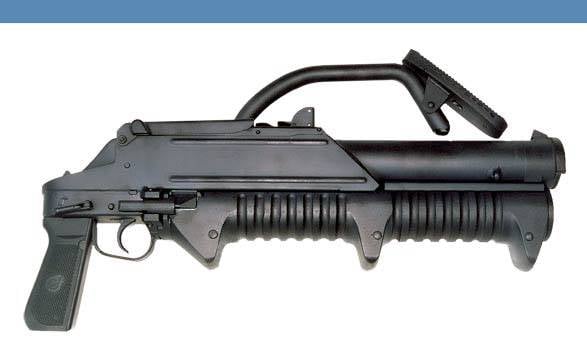
As it is easy to guess by the designation of grenade launchers, their release was adjusted in 93 and 94 year. It makes no sense to consider these grenade launchers as two different models; rather, it is the development of one idea - the creation of a manual multiply charged grenade launcher, based on the already well-known and proven years of design only from the positive side.
The most significant difference between the GM-93 and the GM-94 is the location of the magazine and the barrel of the weapon. In the first embodiment, the store was located on the "classical scheme" under the barrel, in the updated version of the store was moved over the barrel. From a practical point of view, this gave a huge plus in the form of a decrease in the barrel's discharge from the aiming line after the shot, since the centerline of the barrel became even lower than the line of rest in the shoulder of the shooter. Accordingly, in a shorter period of time, the shooter can manage to produce a greater number of aimed shots, although against the background of the presence of manual reloading, this statement can be doubted from all sides.
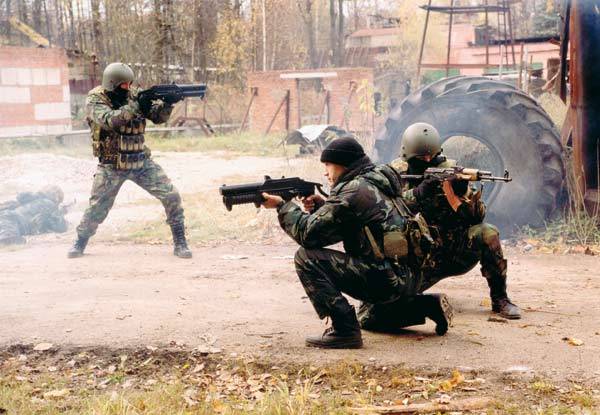
The grenade launcher is powered from a tubular magazine with an 3 grenade launcher capacity, an additional fourth shot may be in the breech of the weapon. Recharging is carried out when moving the forearm back and forth. The equipment of the store is carried out on top of the receiver, through the lid that is folded forward, the ejection of the spent case is carried down, that is, the internal mechanisms of the weapon are maximally closed and protected from dirt. What is in common with the simplest reloading mechanism and the form of a grenade launcher provides reliable and reliable operation of the grenade launcher in adverse conditions and in any position of the weapon.
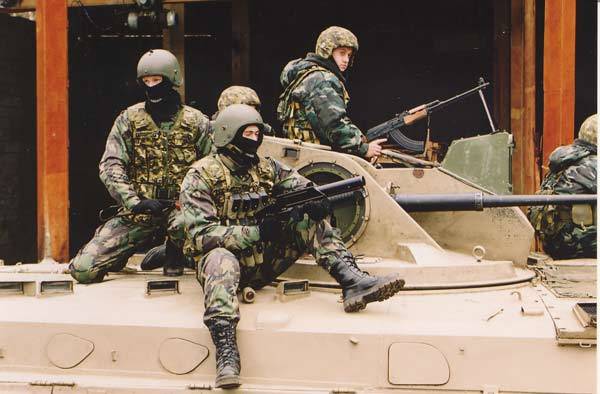
This grenade launcher was created, both for the needs of the army and for the police, which explains the rather good range of ammunition. The device is powered by VGM93 shots with a millimeter 43 caliber. At the moment there are 9 different grenade launcher options. Training, fragmentation, smoke and noise-noise shots no longer surprise anyone, but in addition to them there are also quite interesting shots with thermo-pressure equipment, and the minimum distance for using such ammunition is equal to 10 meters. The projectile itself can pierce 40 millimeters of pine wood, which allows it to be used in enclosed spaces through interior doors.
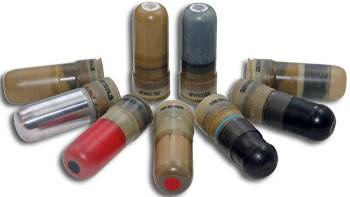 For law enforcement agencies developed ammunition equipped with irritating compounds, among which there is a traumatic. Ammunition, so-called, traumatic, and as far as is clear from the description, it is about “neutralizing offenders with minimal damage to health due to exposure to them with a percussion element”, that is, a striking element in the amount of one piece, and not rubber grit.
For law enforcement agencies developed ammunition equipped with irritating compounds, among which there is a traumatic. Ammunition, so-called, traumatic, and as far as is clear from the description, it is about “neutralizing offenders with minimal damage to health due to exposure to them with a percussion element”, that is, a striking element in the amount of one piece, and not rubber grit.As a result, we get a rather interesting and effective weapon-ammunition complex, which, by the way, looks quite modern, compared to other samples, which is also important by today's standards, when beauty in the market is set equal to functionality.
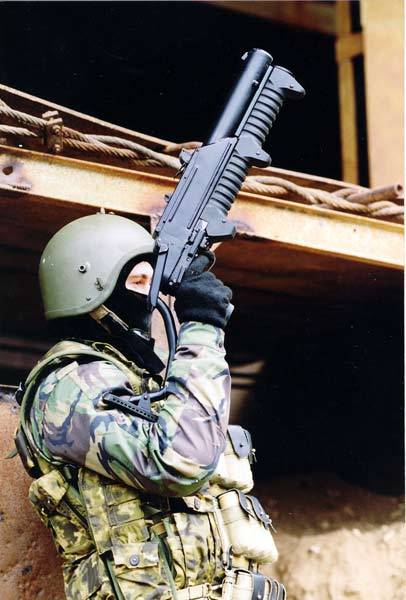 If we talk about weapons in numbers, we have the following. The mass of the GM-94 grenade launcher without ammunition is 5 kilogram. Aiming range of fire up to 300 meters, with a strong desire, you can throw a grenade on 500, only here is luck, not aimed fire. The total length of the weapon with the butt folded out is 820 millimeters, with the folded 545 millimeters. But such compactness is deceptive, because of the design of the butt, in the folded position, it increases the height of the weapon from 280 to 320 millimeters, but this is only critical when placing the weapon in the boxes.
If we talk about weapons in numbers, we have the following. The mass of the GM-94 grenade launcher without ammunition is 5 kilogram. Aiming range of fire up to 300 meters, with a strong desire, you can throw a grenade on 500, only here is luck, not aimed fire. The total length of the weapon with the butt folded out is 820 millimeters, with the folded 545 millimeters. But such compactness is deceptive, because of the design of the butt, in the folded position, it increases the height of the weapon from 280 to 320 millimeters, but this is only critical when placing the weapon in the boxes.If the previous two samples of grenade launchers were interesting for their design, then GM-94 is interesting primarily for its ammunition, and the ease of implementation of the weapon itself, which is also sometimes interesting. Objectively, there are very few tasks in the open area for this hand-held grenade launcher that the grenade launcher would not have done, but for use in the city limits or by law enforcement agencies this weapon seems much more acceptable in its characteristics than the two previous samples with automatic recharging.
Manual "non-lethal" grenade launcher RGS-33
The word “non-lethal” in relation to a grenade launcher looks just as unnatural as the nearby word “silent”, nevertheless, such grenade launchers exist, but about silent grenade launchers some other time, until we dwell on really high-quality, and most importantly effective traumatic gun with butt. Well, it does not turn to call CGS-33 a grenade launcher, although who am I to violate the weapon classification?
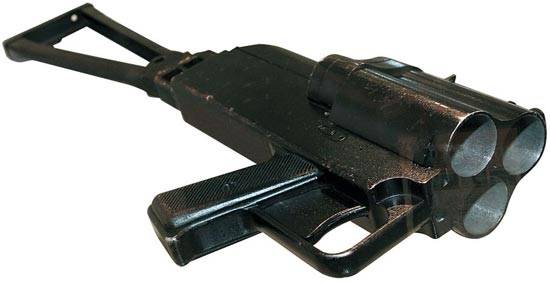
Despite its "non-lethal", the CGS-33 hand-held grenade launcher was not designed to disperse the crowd, it was created for use in the assault of buildings, for arming counter-terrorist units. That is, weapons and shots were developed for him with an eye to the fact that hostages could be in the same room with the enemy, which explains the range of ammunition. Used to fire all 4 type shots. Among them are two variants of traumatic EG-33 and EG-33М, with one large rubber attack element and with a rubber shot, respectively. Shot equipped with an irritating substance GS-33, as well as a flash-noise grenade GSZ-33. As it is not difficult to guess, the caliber of the weapon 33 millimeters.
The weapon looks, to put it mildly, strange, but the appearance does not affect its effectiveness. As such, the barrels of the grenade launcher RGS-33 not, instead of them there is a block of three chamber. A small amount of powder composition, accelerating the missile projectile, all up to 50 meters per second, and the absence of trunks affect the effective range of fire - only 25 meters. However, when it comes to indoor use, this distance is more than enough. What is really strange in this grenade launcher (like foam plastic on glass) is the presence of a rather heavy folding stock. And it's not that the butt is not needed, although you can shoot a weapon like a pistol, you could restrict yourself to something more light, in the form of retractable wire, which would reduce the total weight of the weapon, which is 2,5 kilogram without ammunition.
The principle of operation of the weapon is as simple as possible. Shots are inserted into the forward block of the chamber chamber, after it is closed, when the trigger is pressed, the drummer is cocked and rotated 120 degrees, after a stall. Thus, after 3 shots, the drummer goes full circle and after reloading begins work from the same place from which the first shot was fired the previous time.
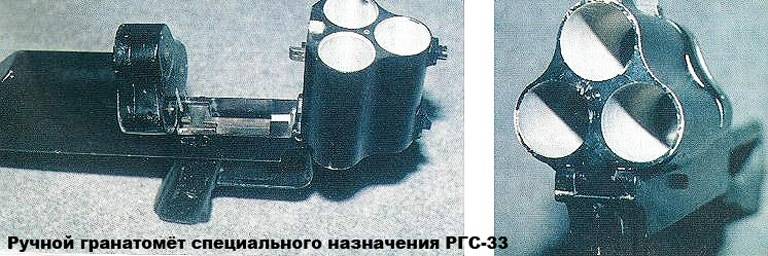
Such a system is good in its simplicity, but it also has disadvantages, which, although far-fetched, are present. First of all, in the CWG-33 there is no possibility of choosing the type of ammunition. That is, ammunition is used consistently, and if it does not reach what is needed specifically at that moment, say, traumatic, then you have to use what is. Back you need to keep in mind the position of the drummer, if you need to replenish the ammunition not fully consumed. In other matters, given that such weapons very rarely need to be reloaded, then all this fades into the background.
Despite the fact that this device has long established itself as an assault weapon, for some reason I see it as just a means of self-defense, and “non-lethal action”, but really effective, except that the weight is embarrassing.
"Underwater" hand grenade launcher DP-63
Since the exotic has gone in the form of a “non-lethal” grenade launcher, then why not mention the “underwater” grenade launcher? In fact, the underwater DP-63 is not, of course you can shoot from it underwater, but only as a rather extravagant way of suicide. This product was developed as part of the Nepryadva program, the purpose of which was to create an effective anti-sabotage tool for protecting ships, one of the results of the work was the DP-63 dual-charge grenade launcher.
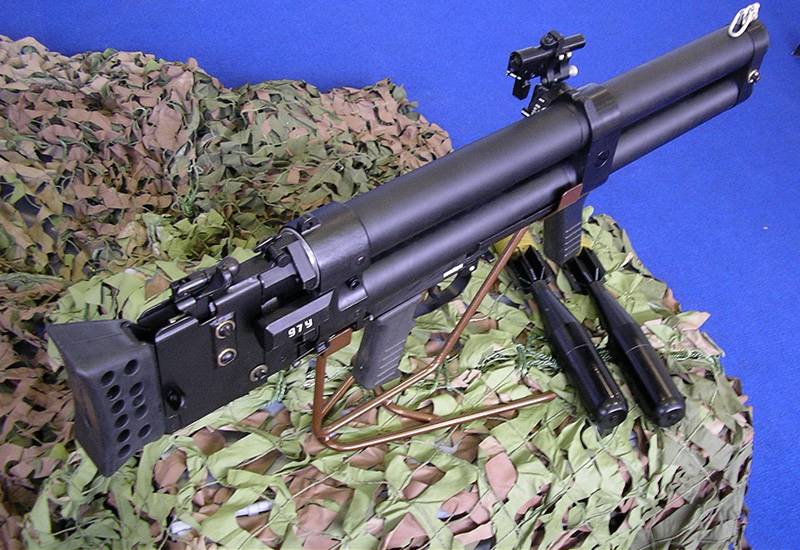
The manual grenade launcher DP-63 itself consists of a block of two smooth barrels and a butterfly valve, the back of which is also an emphasis in the shoulder when firing. Firing takes place alternately. On the trunks themselves there is a handle for a more comfortable retention, and sighting devices are placed on them. The pistol grip is also mounted on the trunks, although it may seem that it is rigidly connected to the bolt of the weapon. Recharging takes place when the valve is retracted and turned. In other words, the design of the weapon is the simplest, it may be even simpler that a slingshot.
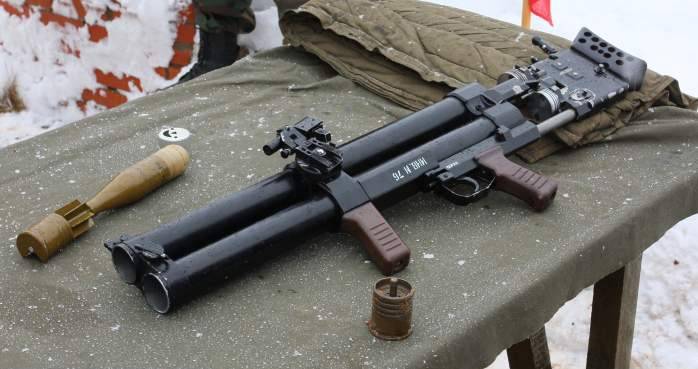
Much more interesting ammunition for this weapon. Only two types of shots have been developed for the DP-63 grenade launcher. The variant with the designation SG-43 is a lighting ammunition. When hitting a grenade body with water, an expelling charge is triggered, which pushes a pyrotechnic torch, the burning time of which is 50 seconds. Such ammunition is needed, both to mark the location of the enemy swimmer, and to make amendments before using the high-explosive ammunition.
A shot with a high-explosive grenade is also not so simple. Its fuse can be installed in two positions: for shallow and deep water, depending on how deep the swimmer is. Denoted by this ammunition FG-43. After the grenade hits the water surface, the fuse is triggered, if it was installed at a shallow depth, the blast occurs at a depth of about 10-15 meters, with a guaranteed defeat of the swimmer at a distance of 14 meters from the explosion site. When installing a fuse to a greater depth, the grenade explodes already at a depth of 25-30 meters. That is, we get coverage in depth to 45 meters.
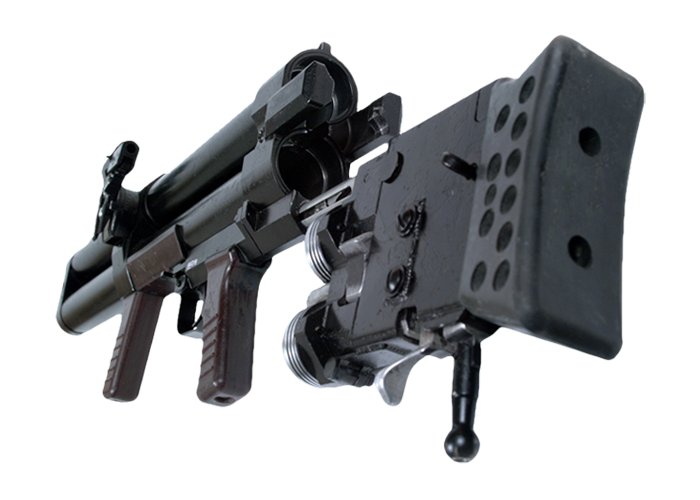
The mass of the DP-63 grenade launcher is 10 kilograms without shots, the weight of the shot itself is equal to 650 grams. The total length of the weapon is 830 millimeters, with the barrel length equal to 600 millimeters. Aiming range of fire to 400 meters. If I correctly understood the principle of the action of the fuse, then firing on land is also allowed, the main thing is that the head of the grenade encounters an obstacle, the only nuance will be the delay before the explosion, though how effective it will be without splintering ...
Conclusion
As it is easy to see, domestic multi-row manual grenade launchers can not boast of their diversity. Of course, this weapon is not so massive, and the tasks for such products are not daily. Yes, and those tasks that are there, can be solved by single-shot weapons. But despite this, it is difficult to argue that in certain situations such a hand-held grenade launcher may be more effective, which means that such a weapon, if not necessary, then at least not superfluous. In the end, you just need to keep up with other countries, and at the moment the lag on hand grenade launchers becomes obvious, not by the number of different weapon options, but by the principle of the same grenade launchers. But about modern foreign hand grenade launchers - in another article.
Sources of photos and information:
zonwar.ru
weaponland.ru
kbptula.ru
russianarms.ru
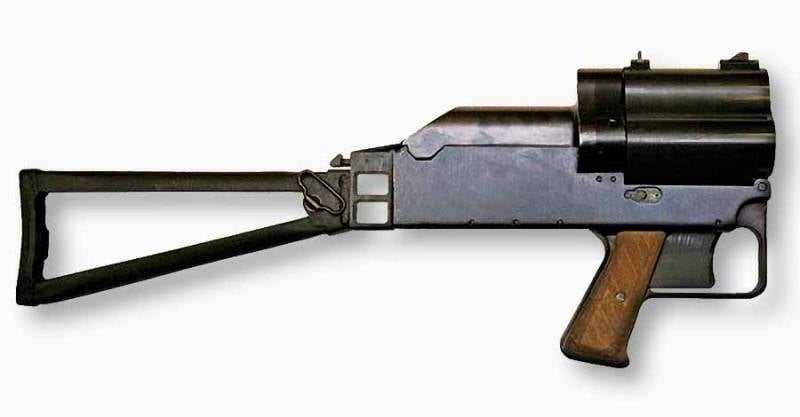
Information